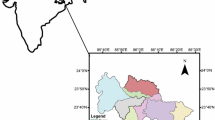Abstract
In the present study, potential zones for artificial recharge in Agniar-Ambuliar-Southvellar river basins in Tamilnadu, India have been delineated through integration of various thematic maps using Arc view GIS. The study area, covers an area of 4566 km2. Thematic maps pertaining to geology, permeability, effective soil depth, drainage intensity, soil texture, water holding capacity and physiography were prepared on 1:2,50,000 scale using conventional methods. These maps were scanned and registered with reference to a base map and are prepared as separate layers or coverages using Arc view. GIS has been used for the integration of various thematic maps to delineate the potential zones for artificial recharge. Each theme was assigned a weightage depending on its influence on groundwater recharge. Each class or unit in the map was assigned a knowledge based ranking from one to four depending on its significance in storage and transmittance of groundwater. The final map has been prepared showing four different categories of potential zones for artificial recharge.
Similar content being viewed by others
References
Chi, K. and Lee, B. (1994). Extracting potential groundwater areas using remotely sensed data and Geographic Information Techniques. Proc. Reg. Sem. Integrated Applications of Remote Sensing and Geographical Information Systems for Land andWater Resources Management, held at Bangalore, India, from Nov. 16–19,1994, pp. 64–69.
Das, S., Behera, S.C, Kar, A., Narendra, P. and Guha, S. (1997). Hydrogeomorphological mapping in groundwater exploration using remotely sensed data — A case study in Keonjhar District, Orissa. J. Indian Soc. Remote Sensing,25(4): 247–259.
Elango, K. and Mohan, S. (1997). Technical report on Effectiveness of Percolation Ponds. Indian Institute of Technology Madras, Chennai, Submitted to Department of Science and Technology, New Delhi.
Haridass, V.K., Chandrasekaran, V.A. Kumaraswamy, K., Rajendran S. and Unni, K. (1994). Geomorphological and lineament studies of Kanjamalai using IRS-1 data with special reference to groundwater potentiality. Trans. Instt. Indian Geographers,16(1): 35–41.
Harinarayana, P., Gopalakrishna, G.S. and Balasubramanian, A. (2000). Remote sensing data for groundwater development and management in Keralapura watersheds of Cauvery basin, Karnataka, India. The Indian Mineralogists,34(2): 11–17.
Jothiprakash V., Elango, K. and Mohan, S. (2001). Percolation Ponds-A source for Sustainable drinking water supply in rural areas. Proc. Nat. Workshop on Water Resource and Water Quality Management for Sustainable Drinking Water Supply, TWAD Board, Tamil Nadu, held at Chennai from Nov. 16–17, 2001, pp. III 85–90
Jothiprakash, V., Mohan, S. and Elango, K. (1997). Influence of Percolation Ponds - A Recharging Structure in a Small Watershed. Proc. Nat. Con. Emerging Trends in the Development of Sustainable Groundwater Resources. NCGWS-97, held at JNTU Hyderabad from Aug. 27–28, 1997, pp. 280–289.
Muralidhar, M., Raju, K.R.K., Raju, K.S.V.P. and Prasad, J.R. (2000). Remote sensing applications for the evaluation of water resources in rainfed area, Warangal district, Andhra Pradesh. The Indian Mineralogists,34(2): 33–40.
Obi Reddy, G.P., Chandra Mouli, K, Srivastav, S.K., Srinivas, C.V. and Maji, A.K. (2000). Evaluation of groundwater potential zones using remote sensing data — A case study of Gaimukh watershed, Bhandara district, Maharashtra. J. Indian Soc. Remote Sensing,28(1): 19–32.
Pal, D.K., Khare, M.K, Rao, G.S, Jugran, D. K. and Roy, A.K. (1997). Demarcation of groundwater potential zones using remote sensing and GIS techniques: A case study of Bala valley in parts of Yamunanagar and Sirmaur district, Remote sensing for Natural Resources, Ed. K.V. Ravindranet al, ISRS-NNRMS publication, pp. 395–402.
Pradeep, K.J. (1998). Remote sensing techniques to locate groundwater potential zones in Upper Urmil river basin, District Chhatrapoor — Central India. J. Indian Soc. Remote Sensing,26(3): 135–147.
Pratap Kamaleshwar, Ravindran, K.V. and Prabakaran, B. (2000). Groundwater prospect zoning using Remote Sensing and Geographical Information System: A Case Study in Dala -Renukoot Area, Sonbhadra District, Uttar Pradesh. J. Indian Soc. Remote Sensing,28(4): 249–263.
Pratap Kamaleshwar, Ravindran, K.V., Prabakaran, B. and Jaganathan, C. (1997). Groundwater investigation in Dala-Renukoot area, Sone Valley, Sonbhadra district, UP; Remote Sensing for Natural Resources, Ed. K.V. Ravindranet al., ISRS-NNRMS publication, pp. 403–411.
Ravindran, K.V. and Jeyaram, A. (1997). Groundwater prospects of Shahbad Tehsil, Baran District, Eastern Rajasthan: A remote sensing approach, J. Indian Soc. Remote Sensing,25(4): 239–246.
Singh, L.M., Roy, P.K., Roy, A.K. and Anand, R (1993). Application of Remote Sensing and Geographical Information in Hydrogeologic investigation of Imphal Valley (Manipur). Proc. Nat. Symp. Remote Sensing Applications for Resource Management with Special Emphasis on NE Region, Guwahati, Nov. 25–27, 1993. pp. 143–147
Srivastava, P.K. and Bhattacharya, A.K. (2000). Delineation of ground water potential zones in a hard rock terrain of Bargarh District, Orissa using IRS data. J. Indian Soc. Remote Sensing, 28(2&3): 129–140.
Subba Rao, N. and Prathap Reddy, R. (1999). Groundwater prospects in a Developing satellite township of Andhra Pradesh, India using remote sensing techniques. J. Indian Soc. Remote Sensing,27(4): 193–203.
Subba Rao. N, Chakradhar, G.K.J., and Srinivas, V. (2001). Identification of ground water potential zones using Remote Sensing Techniques in and around Guntur Town, Andhra Pradesh, India. J. Indian Soc. Remote Sensing, 29 (1& 2): 69–78.
Thomas A., Sharma, P.K., Sharma, M.K. and Anil Sood (1999). Hydrogeomorphological mapping in assessing groundwater by using remote sensing data — A case study in Lehra Gage Block, Sangrur district, Punjab. J. Indian Soc. Remote Sensing,27(1): 31–42.
Tiwari and Rai, B. (1996). Hydromorphological mapping for groundwater prospecting using land sat - MSS Images — A case study of Part of Dhanbad District, Bihar. J. Indian Soc. Remote Sensing,24(4): 281–285.
Author information
Authors and Affiliations
About this article
Cite this article
Jothiprakash, V., Marimuthu, G., Muralidharan, R. et al. Delineation of potential zones for artificial recharge using gis. J Indian Soc Remote Sens 31, 37–47 (2003). https://doi.org/10.1007/BF03030750
Received:
Revised:
Issue Date:
DOI: https://doi.org/10.1007/BF03030750




